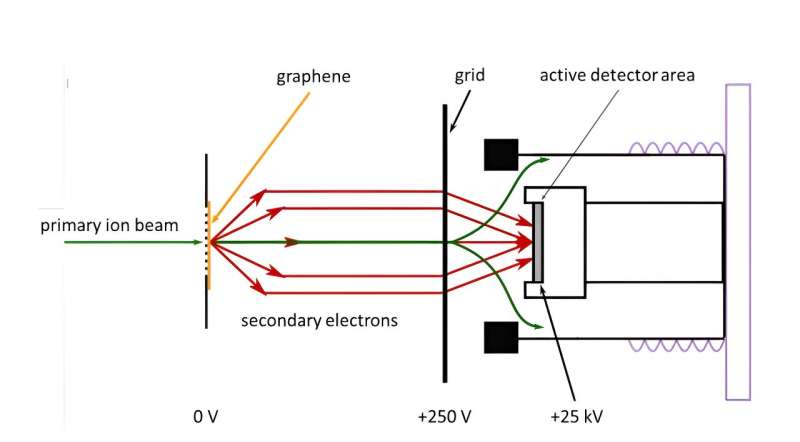This article has been reviewed according to Science X's editorial process and policies. Editors have highlighted the following attributes while ensuring the content's credibility:
fact-checked
peer-reviewed publication
trusted source
proofread
Ion irradiation offers promise for 2D material probing

Two-dimensional materials such as graphene promise to form the basis of incredibly small and fast technologies, but this requires a detailed understanding of their electronic properties. New research demonstrates that fast electronic processes can be probed by irradiating the materials with ions first.
A collaboration involving researchers at the University of Illinois Urbana-Champaign and the University of Duisburg-Essen has shown that when graphene is irradiated with ions, or electrically charged atoms, the electrons that are ejected give information about the graphene's electronic behavior.
Moreover, the Illinois group performed the first calculations involving high-temperature graphene, and the Duisburg-Essen group experimentally verified the predictions by irradiation. This research was reported in the journal Nano Letters.
"Irradiating materials and observing the change in properties to deduce what's going on inside the material is a well-established technique, but now we are taking first steps towards using ions instead of laser light for that purpose," said André Schleife, the Illinois group lead and a professor of materials science & engineering.
"The advantage is that ions allow highly localized, short-time excitations in the material compared to what laser light can do. This enables high-precision studies of how graphene and other 2D materials evolve over time."
When an ion collides with a 2D material, energy is transferred to both the atomic nuclei and electrons. Some of the electrons are given enough energy to be ejected from the material. The features of these so-called "secondary electrons" are determined by the characteristics of the electrons in the material such as their temperature and distribution of energies.
"There's a delay between the ion's 'impact' and secondary electron emission, and that's the key piece of information that we were after in our simulations," said Yifan Yao, the study's lead author and a graduate student in Schleife's research group. "We did this for graphene at absolute zero with no thermal energy present as well as graphene that has thermal energy and a higher temperature. We're actually the first to be simulating 'hot' graphene like this."
The Illinois group performed calculations based on graphene irradiated with hydrogen ions—bare protons—and computed how secondary electrons were released over time and their resulting energy spectrum. These results agreed well with the Duisburg-Essen group's results that used argon and xenon ions.
In addition, the computational study provides insight into the underlying mechanisms of secondary electron emission. High-temperature graphene released more secondary electrons, and a careful examination of the charge distributions indicated that the atomic nuclei in the material's lattice rather than the material's electrons are responsible.
According to Schleife, the promise of this technique goes beyond precision 2D material measurements. "Looking years into the future, there's a possibility that ion irradiation can be used to deliberately introduce defects into materials and manipulate them," he said. "But, in the near term, we have shown that irradiation can be used as a high-precision measurement technique."
More information: Yifan Yao et al, Nonequilibrium Dynamics of Electron Emission from Cold and Hot Graphene under Proton Irradiation, Nano Letters (2024). DOI: 10.1021/acs.nanolett.4c00356
Journal information: Nano Letters





















